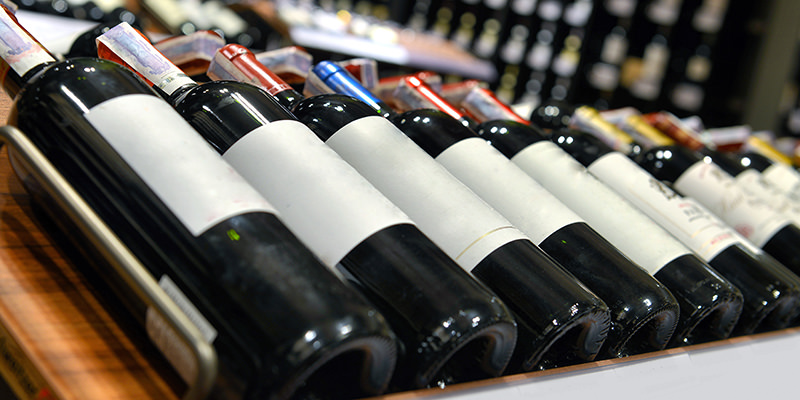It may be a cliché, but it’s true: the medium is the message. But what about when it comes to food and, more specifically, wine? Do the labels on bottles drive consumers to certain wines over others? New businesses that pair graphic designers with winemakers seem to be betting on the idea that good labels can help sell wine, but are they right? Does the label make the sale?
A non-scientific poll of New York wine sellers revealed opinions across the spectrum as to whether or not, and to what extent, the label on a bottle of wine can influence buyers. “In retail it certainly makes a difference,” says Nathan Larson over at Angel’s Share Wines, a Brooklyn Wine Wholesaler and Importer. The most sought after bottles have something on them that grabs your attention. A label with a painting, for example, will always have customers asking after it. Customers are drawn to “something artsy,” Larson said.
But Jamie Wolff at Chambers Street Wines disagrees. “Labels have an effect, but not a big effect,” Wolff told Vinepair. It plays a secondary role to the type of wine a customer is in the market for, or the price they are looking for. The label might be a deciding factor when a customer is deciding between two wines at the same price, but Wolff doesn’t see any consistency between which wines do well and their labels.
Over at Union Square Wines and Spirits, Katherine Moore is also skeptical. “Labels influence buyers somewhat,” she allowed, but only buyers who aren’t wine aficionados. Wine enthusiasts are “more interested in what’s in the bottle,” Moore said, and make up about 60 percent of her customer base. The other forty percent are attracted to labels with contemporary designs and colorful graphics. There are also missteps, Moore said, like when more serious wines are “unfortunately” burdened with humorous labels, which makes them harder to sell.
But Gary at Bottlerocket Wine and Spirit is with the “yays”.“Labels affect consumers a lot,” he told VinePair. “Packaging can make or break a product.” John Samuel, owner of Breukelen Cellars in Bed Stuy, agrees. “It’s pretty obvious that the nature and structure and color and bottle shape and size are all relevant to the decision of the consumer,” he says.
No one’s going to serve a wine called ‘Mommy’s Time Out’ at a dinner party.
Things that work are straightforward labels that say what they are—bright labels with eye catching graphics and contrasting shapes. Also, word play is a big plus, as is irony—Breukelen is in Brooklyn, after all.
On the flip side, dark glass makes a white wine hard to sell, while clear glass makes a red hard to move. “Animals are never a good thing for my customer base,” Samuel said.
How do the experiences of wine sellers match up with the science of advertising?
At its core, says Brittany Duff, Professor of Advertising and Communications at the University of Illinois at Urbana-Champaign, advertising is about creating a connection in the consumer’s mind between an occasion and a brand. In other words, it comes down to a lot of basic conditioning, and this is as true of wine as of anything else. “No one’s going to serve a wine called ‘Mommy’s Time Out’ at a dinner party,” says Duff.
In general, national campaigns tend to work by conveying the impression that a product is popular, and that there is a large supply of it, so consumers can expect it to be available when they want it. Some wines like Yellow Tail have run effective national campaigns.
But when you have a prestige product like, say, a nice or pricey wine, the metric changes. As a brand, you want the opposite of what you would want with a national campaign. You don’t want people to think you have a ton of supply, or that everyone is going to be able to get their hands on the product. Instead, with a prestige product, you want to convey a sense of exclusivity. You want customers to believe that the product will be difficult to come by, and that only the lucky, or the affluent, or those of incredible taste, will be able to procure it. To achieve such an effect, a significantly smaller and targeted marketing campaign would be most effective, says Duff.
Then there’s the fact that Millennials don’t connect to traditional marketing. People in the 18-34 age bracket aren’t watching television anymore, plus they tend to prefer prestige brands and they respond to the kinds of marketing used to sell them— marketing that suggests exclusivity, or a product that not everyone would even want. Advertisers would want to convey that the product is special, comes in a small batch, and conveys individualized, special experiences. “You’d want to note what the experience is that the product is part of,” Duff said. “And you’d want to create an image that isn’t pretty, but is maybe even strange, or ugly, an inside joke of sorts.” Before old fashioned mustaches got so big, they would be a perfect image with which to market a prestige product.
“Millennials are spending their money on experiences, not objects,” Duff said. And because marketing involves associating occasions with products, marketing effectively to Millennials involves “trying to think about who they are and what kind of moments they have in their lives.”

